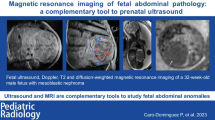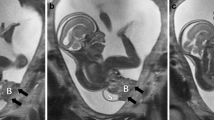Abstract
We report a case of body stalk anomaly detected prenatally by fetal magnetic resonance imaging (MRI) at 14 weeks’ gestation. A 29-year-old woman was followed during her first pregnancy. At 11–12 weeks’ gestation, our sonographic images showed multiple fetal deformities. An abdominal wall defect was suspected. The exteriorized abdominal contents and the lower limb appeared within the extraembryonic celom with an intact amniotic membrane. Fetal MRI at 14 weeks’ gestation confirmed a large anterior wall defect with herniation of the liver and bowel. In addition, abnormally rotated lower limb and scoliosis could be demonstrated. The fetus was prenatally diagnosed with body stalk anomaly, expected to be lethal in nature. The parents decided to terminate the pregnancy at 15 weeks’ gestation. Prenatal diagnosis of body stalk anomaly is usually based on sonographic findings. As far as we are aware, this is the first case report of body stalk anomaly satisfactorily diagnosed by fetal MRI in the early second trimester. Fetal MRI scans should provide ground for a precise antenatal diagnosis of body stalk anomaly from early gestation.



Similar content being viewed by others
References
Daskalakis G, Sebire NJ, Jurkovic D, Snijders RJ, Nicolaides KH. Body stalk anomaly at 10–14 weeks of gestation. Ultrasound Obstet Gynecol. 1997;10:416–8.
Becker R, Runkel S, Entezami M. Prenatal diagnosis of body stalk anomaly at 9 weeks of gestation. Fetal Diagn Ther. 2000;15:301–3.
Goldstein I, Winn HN, Hobbins JC. Prenatal diagnostic criteria for body stalk anomaly. Am J Perinatol. 1989;6:84–5.
Chan Y, Silverman N, Jackson L, Wapner R, Wallerstein R. Maternal uniparental disomy of chromosome 16 and body stalk anomaly. Am J Med Genet. 2000;94:284–6.
Ginsberg NE, Cadkin A, Strom C. Prenatal diagnosis of body stalk anomaly in the first trimester of pregnancy. Ultrasound Obstet Gynecol. 1997;10:419–21.
Daskalakis G, Pilalis A, Papadopoulos D, Antsaklis A. Body stalk anomaly diagnosed in the 2nd trimester. Fetal Diagn Ther. 2003;18:342–4.
Levine D. Fetal magnetic resonance imaging. J Matern Fetal Neonatal Med. 2004;15:85–94.
Hubbard AM. Ultrafast fetal MRI and prenatal diagnosis. Semin Pediatr Surg. 2003;12:143–53.
Gupta P, Jain S. MRI in a fetus with Meckel-Gruber syndrome. Pediatr Radiol. 2008;38:122.
Higuchi T, Tanaka M, Kuroda K, Yabuno A, Kim SH, Asai S, et al. Abnormal first-trimester fetal nuchal translucency and amniotic band syndrome. J Med Ultrasonics. 2012;39:177–80.
Conflict of interest
The authors declare that they have no conflict of interest.
Author information
Authors and Affiliations
Corresponding author
About this article
Cite this article
Higuchi, T., Sato, H., Iida, M. et al. Early second-trimester diagnosis of body stalk anomaly by fetal magnetic resonance imaging. Jpn J Radiol 31, 289–292 (2013). https://doi.org/10.1007/s11604-013-0182-z
Received:
Accepted:
Published:
Issue Date:
DOI: https://doi.org/10.1007/s11604-013-0182-z




